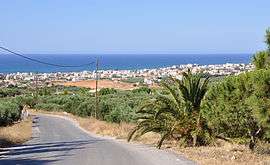Gouves, Greece
| Goúves Γούβες | |
|---|---|
|
View of Kokkíni Háni | |
 Goúves | |
|
Location within the regional unit  | |
| Coordinates: 35°18′48″N 25°18′48″E / 35.3134°N 25.3134°ECoordinates: 35°18′48″N 25°18′48″E / 35.3134°N 25.3134°E | |
| Country | Greece |
| Administrative region | Crete |
| Regional unit | Heraklion |
| Municipality | Hersonissos |
| Population (2011)[1] | |
| • Municipal unit | 10,731 |
| Community[1] | |
| • Population | 3,031 (2011) |
| Time zone | EET (UTC+2) |
| • Summer (DST) | EEST (UTC+3) |
| Postal code | 710801 |

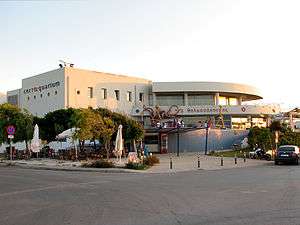
Gouves (Greek: Γούβες) is a town and former municipality in the Heraklion regional unit, Crete, Greece. Since the 2011, local government reform it is part of the municipality Hersonissos, of which it is a municipal unit.[2] It lies a few kilometers east of Heraklion.
Goúves proper is often confused with its busy summer resort, Káto Goúves. Besides this well developed tourist resort with long sandy beaches, the area has some traditional villages and archaeological sites and Eileithyia caves. West of Goúves are the tourist resorts of Kokkíni Háni (also spelled Háni Kokkíni) and Amnísos, both with similar attractions, and, to the east, Crete's largest resort, Hersonisos.
Goúves proper is located about 20 km (12 mi) east of Heraklion. Káto Goúves, just a couple km north of the village, with its long sandy beach, is the summer resort. There is a variety of accommodation, from large hotels to boarding houses and self-catering apartments, and there are many restaurants, bars, nightclubs, and shops.
Main villages in Municipal Unit of Gouves
Anopoli Village
The village Anopoli is located just some minutes from Kokkini Xani village, 5 km south in the mountains at an altitude of 205 m. Entering the village of Anopoli, visitors will admire its square, Agia Triada church and the war monument Hrwo. The square is made of cobblestones and offers easy access. Within the square stands Hrwo, a war monument on which is carved the names of the fallen heroes of the village from the German invasion in 1940, it is made of marble and stands in the middle of the square as a constant reminder to locals and visitors, of the sacrifices that offer us freedom to this day. It was unveiled in 1981 and since then memorial services as well as wreath laying is made on every national celebration in their honours. Agia Triada was built in 1969 and significant frescoes adorn its inside. A picturesque village that still preserves the tradition of vegera, a tradition that demands almost every night, visitors and locals to feast on traditional dishes under the starry sky, to the sound of traditional music.
Elia Village
Elia village is located just 12 km southeast of Heraklion city, in the inland of Hersonissos Municipality, and just 4.5 km from Kokkini Chani village by the sea. The village is on a small hill, at an altitude of 230 m offering the visitor a magical and unique view. The local population is basically involved in agricultural production, olive oil, wine, grapes, as well as livestock. One of the important points of interest for visitors is the Eileithyia cave, where legend has it that the goddess Hera gave birth to Eileithyia, the goddess of birth. The central square of the village is located at its entrance and during the summer months a number of events take place with feasts, music and dances.
Epano Gouves Village
Epano Gouves village is located on the south side of Gouves village by the north side of Ederi Mountain, just 18 km east of Heraklion city and just 3 km from Gournes village. Access to the village is by the old national road of Heraklion- Lasithi and through a vertical road that runs through the village from one side to the other. The village is known for the characteristic quiet and picturesque atmosphere that in compilation with the traditional cafes, taverns churches and heroic monument combine a beautiful destination. The Agios Ioannis and Agios Georgios churches were built in the 18th century and are decorated with magnificent and enviable frescoes of historical and religious importance; both of them maintain an active role within the community. The main square of the village includes traditional cafes and taverns under the shade of eucalyptus and myrtle trees with a view of the old Town Hall which today is used for local community purposes. Ending with the historical war monument, Hrwo, a shining reminder of the local resistance to the German invasion during WW2 that led to the ultimate sacrifice. The names of the heroes are carved on marble a time lasting material that the monument was made of.
Epano Vatheia
Epano Vatheia village is located in the valley of Vatheianos Kampos, at an altitude of 260 m in the inland of Hersonissos Municipality, just 15 km southeast of Heraklion city. It is a characteristic example of traditional villages in Crete, traditionally built, based on the Cretan culture. Its population is mostly engaged in agricultural production, producing exceptional olive oil, wine and grapes. The main square of the village is decorated with berry trees and poplars that combined with the traditional cafes offer an ideal as well as a vivid atmosphere. During the summer period a number of events and celebrations take place in the square, where locals and visitors celebrate with traditional food, drinks, music and dances.
Gournes Village
Gournes village is by the sea and is located just 15 km east of Heraklion city in the Municipality of Hersonissos. The Town Hall is situated, within the old American Base, also located in the old base is the Crete Aquarium where the visitor can see the underwater flora and fauna of the whole Mediterranean Sea in its facilities. The Exhibition Centre as well as the school cluster of kindergarten, junior high school and high school of the area is within the base limits. The village has an easy and fast access through the old national road of Heraklion- Lasithi and in this main road we find the main church of the village, the Euaggelistria church, where the visitors can admire the enviable frescoes as well as the Hrwo Monument that stand in its yard. A war monument made of marble with all the names of those who gave their lives in the fight against the German invasion during WW2 for freedom, are carved. The coastline is full of traditional taverns and cafes that will fulfill every need of the visitor combined with crystal clear sea and sandy beaches.
Gouves Village
Gouves village is also known as Kato Gouves. It is a village by the sea with a clear tourist orientation; located 18 km east of Heraklion city and just 3 km from Gournes Village. There is easy and fast access to the village by following the old national road of Heraklion- Lasithi and then taking the vertical road that runs across the village as its main road that ends up at its coastline. At the entrance of the village visitors will see the Central Fountain that provides lots of cool and rejuvenating water and also a wide parking area. Alongside in the main road we meet a vast number of local hotel resorts with a range of 5-star hotels to simple room to let facilities that will fulfill every need of accommodation even for the most demanding visitors. Moreover, on the main road a number of local businesses provide clothing, jewellery, gifts shops as well as taverns with delicious cuisine. Ending on the coastline of the village a number of cafes, taverns and clubs will conclude a full spectrum of things to do and places to visit, with a unique atmosphere of both romantic and rejuvenating essence for every visitor to live and experience.
Haraso Village
Haraso village is located southeast of Heraklion city just 27 km from the airport and at an altitude of 388 m, in the inland of Hersonissos Municipality just 10 km south of Gouves village. Locals mainly work in agricultural production and development, and as a result produce exceptional quality olive oil, wine, grapes as well as raisin. The church of Agios Eustathios is outstanding and is known for its magnificent frescoes that decorate its inside and also for the altar that keeps the holy remains of Agios Eustathios. The Eftazimo bread as well as the Capri of the village is known for their relish and the traditional way of making them by the women in the village. A picturesque village, that offers a magical view and a delightful trip to the world of taste for every visitor.
Kalo Chorio Village
Kalo Chorio village is located just 7 km south of Gouves village and 25 km southeast of Heraklion city, in the inland of Hersonissos Municipality. The panoramic view of the village combined with the wild beauty of the site, make it a unique destination. Its square, its traditional cafes, and moreover its old and enviable churches complete the image of a clearly Cretan traditional village. The hospitable locals mostly work on olive oil production; as a result they produce one of the most exceptional quality olive oil products. During summer, visitors can wander in the alleys of the village as well as visit the church of Metamorphosis Sotiros, where they can admire the magnificent frescoes on the inside of the church which date back to the early 19th century.
Karteros Village
Karteros village is located by the sea just 8 km from Heraklion city and is the natural limit of Hersonissos Municipality. A magnificent gorge, which lies across its area, a magical coastline full of crystal clear sea and sandy beaches, and finally the picturesque church of Agios Ioannis and Agios Nikolaos that is literally built in the depths of a huge rock, complete the excursion to Karteros village. The crystal clear water and beautiful beaches are ideal for swimming and sunbathing and complimented by the local taverns and cafes create a unique and relaxed summer destination. The wild beauty of Karteros Gorge will satisfy even the most demanding lovers of nature
Kokkini Chani Village
Kokkini Xani village is by the sea and is located just 14 km from Heraklion city. A close distance from the village we find the Minoan Palace of Nirou Chani. Along the main road of the village visitors can find local super markets, cafes, banquet centres, hotels and night clubs as well as local bakeries and patisserie. Due to the rapid growth of the population of the village, a need for a new church came up in order to fulfill the religious need of locals, so in the middle of the village visitors will see a magnificent work in progress of the new church of Axion Esti, a cruciform domed with two chapels and a triconch sacred, also in its yard we can see the Cultural and Spiritual Centre of the area. On its coastline a number of taverns cafes and hotels will provide visitors with traditional sea food and more, as well as drinks and cocktails. The outstanding view of Dia Island in compliments the nightlife and the local hospitality making this excursion an unforgettable experience for every visitor.
The name of the village means “Kokkinis’s Inn". It is taken after an inn that operated here in the early 1900s, by someone called Kokkinis. This inn was popular to the farmers, on the way to the Heraklion market with their olives, grapes and other produce. There they could stop off to rest or spend the night, and have a meal. http://kokkini.info/
Koksari Village
Koksari village is located 23 km southeast of Heraklion city and just 5 km from Gouves village, in the inland of Hersonissos Municipality and at an altitude of 180 m. It is built in the Valley of the Karkania River and it is known for its exceptional quality of olive oil production as well as its unique traditional bakery techniques that are kept alive and untouched to this day by the local women. During the summer time, a number of events take place in the village but the one that stands out is the celebration of Agios Kirikos and Ioulitta on the 15th of July, every year. At this time visitors and locals come together and attend the church ceremony that takes place and after together attend the demonstration of traditional bakery techniques that the local women present. At the end all attending take traditional bread and sweets and move on to the square of the village. Closing the night in the square locals and visitors celebrate with a Cretan traditional feast with local dishes, drinks, music and dance making an unforgettable experience.
Skoteino Village
Skoteino village is located just some minutes south of Gouves village. It is a small village, in the inland of Hersonissos Municipality, with great tradition. One of the most admirable points for visitors is the Agia Paraskeui Cave, which is located near the settlement at an altitude of 220 m. It has a total length of 126 m and the gauge of its rooms ranges between 8–50 m. Visitors will also see there a small outdoor theatre, fountains and points of infinite beauty that will impress everyone during their sightseeing. The small outdoor theatre provides a wonderful view, amphitheatrically built stairs- mantels that are used as seats and a small foyer, where a number of events take place during the summer time.
Vatheianos Kampos Village
Vatheianos Kampos is located 13 km east of Heraklion city and borders Kokkini Chani village. Its area starts at the inland of Hersonissos Municipality and ends at its coastline. In Vatheianos Kampos, visitors can see the church of Agioi Theodoroi and the Kokkevi Bridge. Agioi Theodoroi church was renovated in the 20th century and inside the visitor will observe the outstanding frescoes of Agios Theodoros, Panagia the Vrefokratousa, Pantokratoros and Agios Ioannis the Prodromos. The Kokkevi Bridge is located at an altitude of 11 m and beneath it runs the Batheianos River that starts from the settlement of Batheianos Kampos at an altitude of 190 m and ends at the sea. The traditional taverns and the crystal clear sea and sandy beaches of the area make it an ideal destination for visitors that seek relaxation.
Main Points of Interest in Municipal Unit of Gouves
Amnisos
Amnísos and its long sandy beach lies about 7 km East of Heraklion city, just beside the airport and in front of the islet of Dia. There is another Minoan villa in the area dating from 1600 B.C., where some frescoes that are now in Heraklion Archaeological Museum were found.
CretAquarium
One of the largest and most modern aquariums in Europe, CretAquarium was founded and operates as part of the HCMR. It is geographically located on the north-western part of the former American Base of Gournes, where together with the premises of the research institutions of HCMR forms THALASSOKOSMOS - the largest centre for marine science and promotion of the Mediterranean sea world. Visit at www.cretaquarium.gr/en
Dia island
Dia island is located 6 miles northeast of Heraklion city. it is a virgin island and the home of seabirds and species associated with coastal cliffs. It is one of the NATURA protected areas, due to its status as biotope for endemic plants. Legend has it that Dia island used to be a colossal sea creature that came close to Crete and then Zeus turned it into stone with a powerful thunderbolt, thus creating the island.
Eileithyia Cave
This cave lies 1 km inland from Amnísos. It was an important sanctuary since Neolithic times. It was dedicated to Eileithyia, a Greek goddess of fertility and childbirth of Cretan origin. The cave is rectangular, 64m long and 9-12m wide. After the entrance there is an antechamber, which leads to a rectangular room surrounded by cylindrical stalagmites which were probably worshipped by the pilgrims. At the cave's mouth there is a square, known as "The Square of Altars". This courtyard may have been used in ceremonies. The cave remained in use until late Roman times.
Gorge of Karteros
Gorge of Karteros also known as Astrakiano Faragi is located in the Municipal Unit of Gouves and can be entered by Karteros village on the southeast side. It is a destination rich in natural beauty full of flora that only exists in Crete; moreover it is an ideal hiking trail full of ponds and small waterfalls. it will satisfy even the most demanding visitor, offering at the end of the route a frugal structure for visitors to rest.
Kera Eleousa Monastery
One of the most important monasteries in the Municipal Unit of Gouves, located near Voritsi village just some minutes away from Gouves village. A fortress type monastery with significant archaeological ruins. Visitors can admire the church, the monks' cells and the beautiful yard of the monastery as well as experiencing warm hospitality each and every time they visit.
Minoan villa of Kokkíni Háni
The summer resort of Kokkíni Háni lies in Vathiano Kambo, about 13 km East of Heraklion and Northwest of Goúves. At the spot known as Nirou Háni, archaeologists found a well preserved Minoan villa dating from the New Palace period. The villa had two storeys, was about 1000 sq. meters large and had all the typical features of the Minoan architecture: two paved courts, connecting corridors, storage rooms, light wells, shrines, etc. About 40 tripods and huge double axes were found in some rooms, suggesting that the owner of the villa might have been a high priest. Like most of the Minoan buildings, the villa was destroyed by a big fire. The finds from the excavations are now displayed in the Heraklion Archaeological Museum.
Monastery of Saint John Theologos
This monastery (Agios Ioannis Theologos in Greek) lies in a verdant setting Southeast of the village of Anópoli. It used to be part of the Saint George (Agios Giorgios) monastery, which is located to the North, which was abandoned following the frequent pirate raids in the 15th and 16th centuries and all the monks moved to the monastery of Saint John. During the Ottoman occupation of Crete, the monastery hosted Cretan revolutionaries and a secret school, something that lead the Ottomans to destroy it and kill the monks and the people of Anópoli in July 1896. The monastery was founded again some years later.
Skotino Cave
This cave, one of the largest and more impressive among the hundred caves in Crete, is located high on a hill northwest of the village of Skotinó, a few kilometers inland south of Goúves. It is also known as Ayía Paraskevi cave, this name coming from the church built on top of it. The cave is 160m deep and 36m wide. The first archaeologically researches on the site were done by Arthur Evans, the well-known British archaeologist who unearthed and partially restored Knossos in the early 20th century. A more comprehensive exploration was done by French and Greek archaeologists in the 1960s. They found a considerable number of bronze and ceramic votive offerings, the oldest of them dating from the earliest Minoan periods, suggesting the cave was an important sacred shrine dedicated to a female fertility deity, presumably Britomartis. The cave was still used in Classical Greek and Roman eras, when the fertility goddess Artemis or her Roman equivalent Diana replaced the Minoan deity.
Gallery
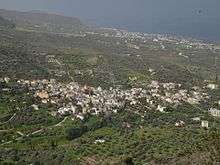 Ano Gouves Village |
 Anopoli Village |
 Archaeological Site of Amnisos |
 Cave of Eilithia |
|---|---|---|---|
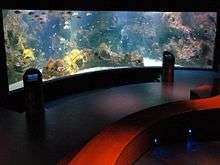 Crete Aquarium |
 Island of Dia |
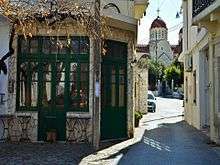 Elia Village |
 Gorge of Karteros |
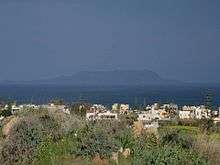 Gournes Village |
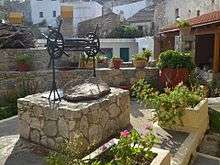 Haraso Village |
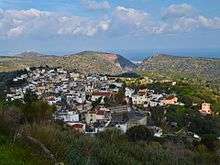 Kalo Chorio Village |
 Karteros Village |
 Skoteino Village |
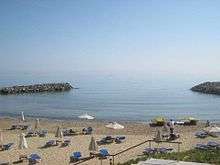 Vatheianos Kampos |
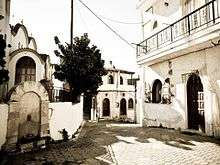 Village Kalo Chorio |
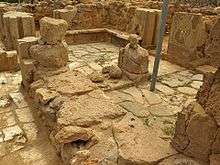 Minoan Palace of Nirou |
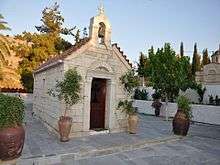 Monastery of Agios Ioannis Theologos |
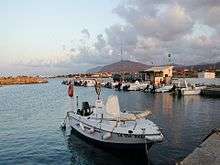 Port of Gournes |
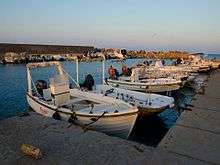 Port of Gouves |
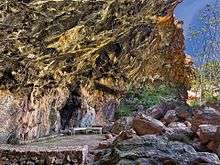 Skoteino Cave |
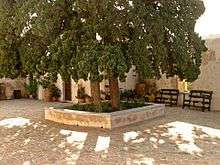 Kera Eleousa Monastery |
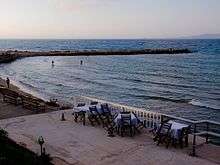 Kokkini Chani Village |
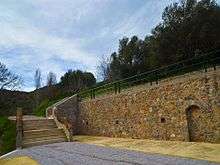 Koksari Village |
References
- 1 2 "Απογραφή Πληθυσμού - Κατοικιών 2011. ΜΟΝΙΜΟΣ Πληθυσμός" (in Greek). Hellenic Statistical Authority.
- ↑ Kallikratis law Greece Ministry of Interior (Greek)
Bibliography
- Fisher, John and Garvey, Geoff (2007). The Rough Guide to Crete, 7th edition.
External links
| Wikimedia Commons has media related to Gouves municipal unit. |
- Gouves Travel Guide from traveleye.com
